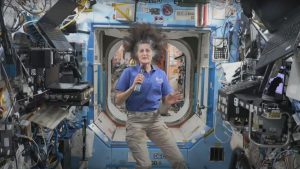How conflict minerals make it into our phones
Tin, tantalum, tungsten and gold. All of these minerals are found in our electronics and all are considered conflict minerals, due to their potential origin in the Democratic Republic of Congo. While the African country contains an estimated $24 trillion in untapped mineral resources, it remains mired in poverty and violence, and mining these four metals can help fund armed conflict in the region.
But the metals are integral to consumer electronics. In a smartphone, for example, tin is used to solder metal components together, while tantalum is used in capacitors, which store electrical energy. Tungsten is used in the components that make a phone vibrate, and gold is used in circuit board connectors.
In the past decade, African countries, intergovernmental organizations and companies have ramped up their efforts to clean up mineral supply chains. But consumers still can’t be sure if the minerals in their electronics are fully conflict-free, or if the mines where they originated are dangerous, environmentally destructive, or use child labor.
“The whole process is muddied,” says Oluwole Ojewale, the Regional Organized Crime Observatory coordinator for Central Africa at the Institute for Security Studies in Dakar, Senegal.
That’s largely because in the DRC and surrounding countries, hundreds of thousands of people work in the informal mining sector, toiling away using hand tools in what are known as artisanal and small-scale mines. This type of mining can be hazardous and difficult to regulate, but it’s also one of the few sources of income available to some of the world’s poorest men and women.
So while companies like Apple, Microsoft, Intel and Tesla put out extensive reports on conflict minerals every year, usually stating that there is no reason to believe the minerals they source help to support armed groups, corruption and instability at mine sites means there are no guarantees.
Apple, Intel and Tesla did not reply to requests for comment, while a Microsoft spokesperson stated, “Microsoft remains committed to responsible and ethical sourcing and takes this issue very seriously.”
“You have the international market that has these perfect standards,” explains Joanne Lebert, the executive director at IMPACT, a nongovernmental organization focused on improving natural resource governance in areas where security and human rights are at risk.
“They want perfect environmental conditions. They want all the development factors taken in, like gender equality and anti-corruption and this and that. They want the perfect package, but that’s not the situation on the ground,” Lebert said.
The situation on the ground
Artisanal miners in the South Kivu Province of the Democratic Republic of the Congo mining cassiterite, the primary ore of tin.
GRIFF TAPPER/AFP via Getty Images
Only about 2% of the world’s tin, tungsten and gold comes from the DRC and surrounding countries, so mining these minerals doesn’t usually help fund armed conflict. But 67% of the world’s tantalum comes from the DRC and Rwanda. And the eastern DRC, where these minerals are found, is mired in violence stemming from historical tensions between the Hutu and Tutsi ethnic groups.
After the Second Congo War ended in 2003, a transitional government was unable to contain armed groups who perpetrated violence against civilians, thus giving rise to self-defense militias. Today, rampant poverty, corruption, and institutional chaos continues to drive many Congolese to join one of the over 120 armed groups operating in the eastern DRC.
“Before the artisanal miners can access the coltan mines or other places, they have to pay taxes to the armed group,” Ojewale said. Coltan is the metallic ore from which tantalum is extracted.
Beyond taxation, these groups fully take over some mines, either extracting the ore themselves or using forced labor, purchasing arms with the proceeds. And conditions in artisanal mines can be quite dangerous.
“I think in the past four or five years, every year we’ve had people being buried underground,” said Nicolas Kyalangalilwa, a pastor and civil society leader in Bukavu, a city in the eastern DRC. “So, it is a very dangerous job, both from a security side, from a financial stability side, from a health and safety side.”
Such conditions also apply to other minerals found in the DRC, like cobalt, which is surging in demand due to its importance in batteries for electric vehicles. Around 70% of the world’s cobalt is mined in the relatively safer southern DRC. It may not be benefiting armed groups, but there are still concerns over working conditions and the use of child labor.
Efforts to trace minerals
With the passage of the Dodd-Frank Act in 2010, U.S. companies are required to disclose their use of conflict minerals.
“If you’re a big company, you’re a name brand, you’re consumer-facing, you can easily spend a million on this,” explained Chris Bayer, principal investigator at the nonprofit International Development. “And the big brands that we all know, they would spend a lot more.”
This has given rise to a web of organizations working to trace and verify supply chains. For example, Apple, Microsoft, Tesla, Intel, Samsung and hundreds of other companies are members of the Responsible Minerals Initiative, which maintains a list of smelters and refiners that have undergone an independent audit to ensure that they’re sourcing responsibly. In its most recent conflict minerals report, Apple said it has removed 163 smelters and refiners from its supply chain since 2009, including 12 in 2021.
Then there are the organizations actually doing on-the-ground tracing and due diligence at mine sites. The International Tin Supply Chain Initiative is the main player in the DRC and surrounding region, working in over 2,000 mines. The organization trains government agents to tag and seal bags that come from registered mines. But no system is foolproof, and if agents are corrupt, they might accept minerals from outside, unregistered mines and tag them anyway.
“You also have the issue where the agents were actually selling the tag to other mines,” says Guillaume de Brier, a natural resources researcher at the International Peace Information Service. “At the end, even when the system was working, those minerals were melted with the minerals from other mines.”
Ultimately, it’s just really hard to stop bad actors in the system. But experts say the answer is not boycotting minerals from the DRC or from artisanal and small-scale mines overall.
A woman in the South Kivu Province of the Democratic Republic of the Congo breaks stones that contain cassiterite, the primary ore of tin.
Tom Stoddart/Getty Images
“If we recognize, for example, that artisanal mining is the most important rural, non-farming activity, employing tens of millions throughout Africa, generally, 30 to 40 percent of which are women, making sure that we’re decriminalizing that and recognizing that as legitimate is the first step to supporting them,” Lebert of IMPACT said.
Lasting change will likely only come when the DRC stabilizes.
“Ultimately the conditions that we see on the ground or the human rights issues that are of concern to us all are very much linked to governance, poverty,” Lebert said. “We need to get at these more systemic issues if we want to see lasting changes in supply chains, not just de-risking in the short or medium term for a company’s benefit.”





